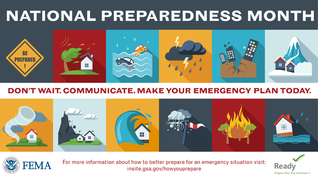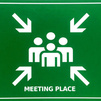 September is National Preparedness Month. This year's theme is: "Don't Wait. Communicate. Make your emergency plan today." Safety of children and staff is always the highest priority for GSA Child Care Centers. It is critical that your child care center has procedures for prevention, preparedness, response and recovery from emergencies. Please take time today to talk to staff, co-workers, and family to review and communicate your plan. Here are some emergency preparedness tips and best practices from the GSA Child Care community...
 How will you communicate with families during a crisis?
Little Eagles in Kearneysville, WV has improved their communication with families with a new texting system which sends mass messages. Enrolled families now receive information in real-time right at their fingertips.
|
 Have you checked your supplies lately?
Please check your center’s emergency supply inventory. Verify your stock and replenish perishable items as needed. For a checklist of recommended supplies and a Provider Emergency Preparedness Toolbox, please visit the “Emergency Management” section of our website at http://www.gsa.gov/portal/category/26340
|
 Who are you going to call?
Do you know who to contact in an emergency? Do your local procedures have you call 911 for medical emergencies and a security desk for others? Make sure your staff knows who to call in different scenarios. Update your contact list today.
|
 Where will you go?
Every center should have three evacuation sites. Know your safe areas and practice with the children. Make sure families and emergency personnel know where your safe areas are located.
|
At the Harry Pregerson Child Care Center in Los Angeles, CA, Center Director Leslie Castenda implemented “calm drills” to create a real time evaluation of emergency preparedness. Calm drills are randomly conducted at least once a month with individual staff members. These drills involve the Center Director entering each classroom, taking the teacher aside and presenting a hypothetical emergency scenario. The teacher then assesses the situation and formulates the most appropriate emergency response. Through this one-on-one process, the Director provides feedback in real-time and an exchange of ideas occurs on how to improve. Calm drills take only ten to fifteen minutes and staff are given different scenarios to practice and think on their feet. These “calm drills” help prepare staff for an actual emergency allowing the staff to put their calm drill practices into action.
Boards also need to consider their own Emergency Plans! A top priority should be succession planning. Succession planning is not a top priority for most nonprofit leaders because they believe the myth that it:
- Requires too much weight/expense at the top
- Compromises authority
- Demands time and leadership and/ or
- Causes discomfort/uncertainty.
Managing succession proactively will calm transition times and make your Board stronger than ever. It energizes and reassures the Board by providing a strategy for unplanned events.
The Anne E. Casey Foundation shared a publication titled "Building Leaderful Organizations: Succession Planning for Nonprofits”. This publication presents emergency succession planning tools- an important risk management practice. Take a look and consider succession planning for your Board of Directors. |